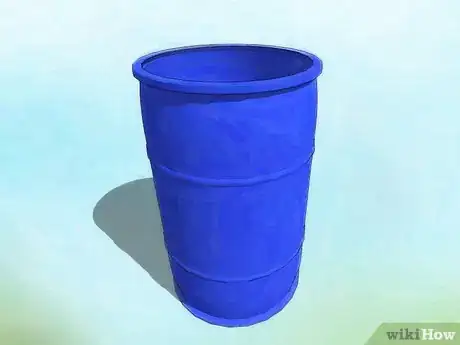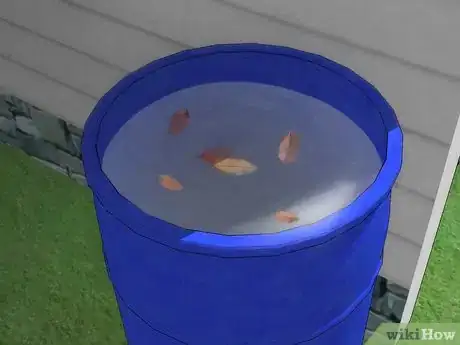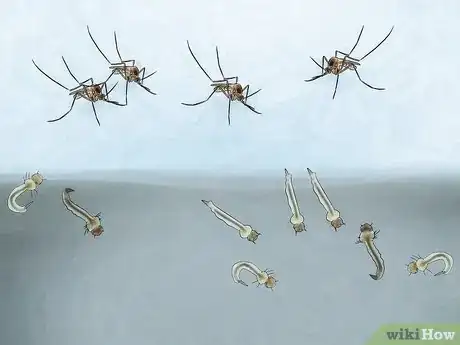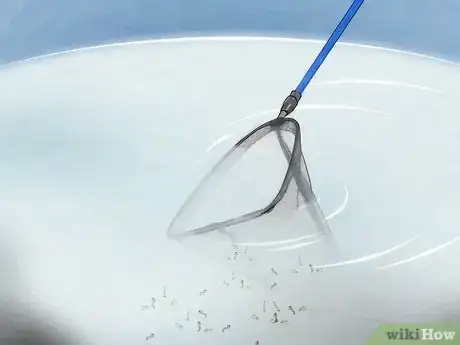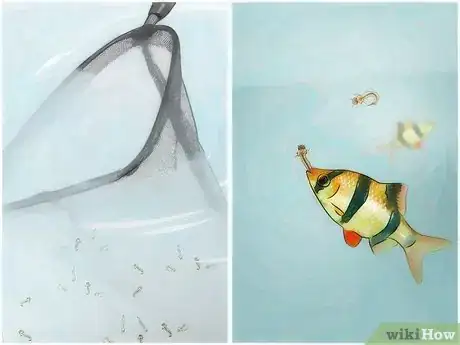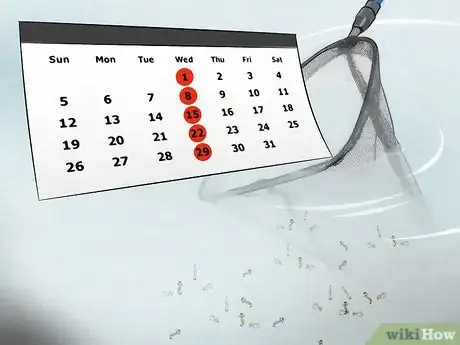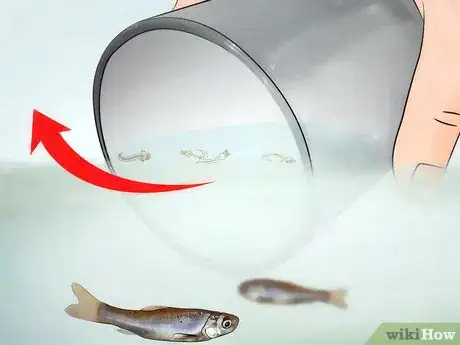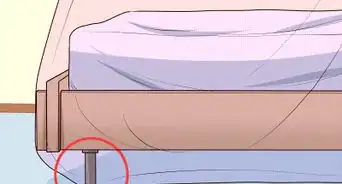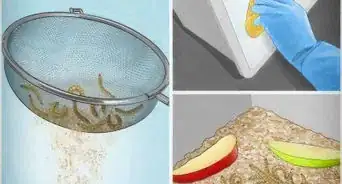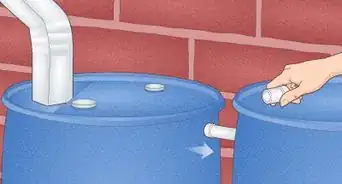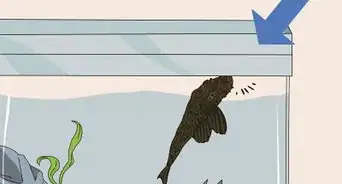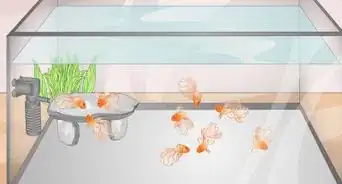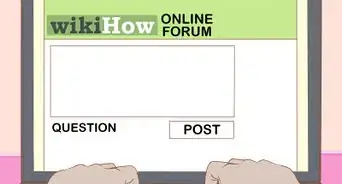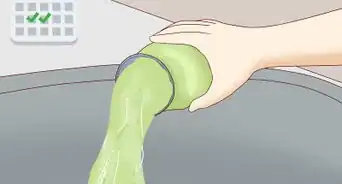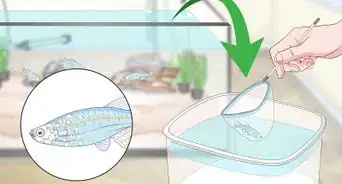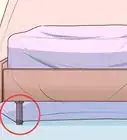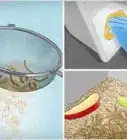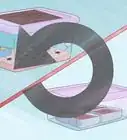This article was co-authored by Pippa Elliott, MRCVS. Dr. Elliott, BVMS, MRCVS is a veterinarian with over 30 years of experience in veterinary surgery and companion animal practice. She graduated from the University of Glasgow in 1987 with a degree in veterinary medicine and surgery. She has worked at the same animal clinic in her hometown for over 20 years.
wikiHow marks an article as reader-approved once it receives enough positive feedback. In this case, 88% of readers who voted found the article helpful, earning it our reader-approved status.
This article has been viewed 236,086 times.
Some fish need to be fed live food, which is often more expensive than flakes or pellets. If you hope to breed your fish, you may have to feed them live food during their mating cycle. Regardless of the reason you choose to feed your fish live food, raising your own could be more convenient and cost effective than purchasing it from pet stores. Raising mosquito larvae is extremely simple and can provide nutritious food for your fish free of charge! All it takes is a container to hold water, a little patience, and a watchful eye.
Steps
Preparing a Friendly Environment for Mosquito Larvae
-
1Get a water container for your larvae. There are many container options that you can choose from to grow mosquito larvae. Larger containers will permit you to grow more larvae, but remember that the larvae you don’t harvest will eventually hatch into mosquitos in your yard. Make sure to use a new or clean food grade container. Do not use one that has held paint, tar, or other chemicals as the chemicals will poison the algae or larva.[1]
- A five-gallon bucket is an excellent choice for your water source, but if you have a large number of fish you intend to feed, you may want to go with something as large a 50-gallon barrel.
- A one-quart container can provide you with enough mosquito larvae to feed most hobbyist’s fish.
-
2Fill your bucket with water.. Clean water often lacks the nutrients mosquito larvae need to survive. If you allow rain water to fill your bucket or other container it will create an environment that can more easily sustain the larvae you hope to breed. You may not want to wait long enough for your bucket or container to fill with rain water. If you choose to use tap water, it's important that you treat the water to make it safe for mosquito larvae, otherwise the chlorine may prevent algae growth, which is the larvae’s primary food source.[2] [3]
- Leave debris that falls into the water. It will add to the bacterial growth mosquito larvae will feed off of.
- Treat the tap water with a dechlorinator that will neutralize the chlorine content that may be present in your tap water.
- Dechlorinator kits can be purchased at most pet or aquarium stores.
Advertisement -
3Place the bucket in a shady area. Mosquitos thrive in dirty, shaded water sources. Avoid placing the bucket in direct sunlight, as the water may become too warm for larvae to survive on hot days. You may spill some water while moving the bucket, but it does not have to be full to work.[4]
- Place the bucket under an overhang or dense tree growth to keep it shaded from the sun.
- It’s okay if sunlight reaches the bucket at times, but position it so it doesn not receive direct sunlight for too much of the day.
-
4Wait for mosquitos to lay their eggs in the water. There are very few retailers that sell mosquito larvae, so you will need to wait for mosquitos to come and lay eggs in your water source. Depending on where you live, this may only happen during the spring and summer months. It will likely only take a week or two to notice mosquito eggs in your water source.[5]
- Mosquito eggs will look like tiny rafts of dark brown eggs. These egg rafts tend to hatch within 48 hours.
- When mosquito eggs hatch, they release what looks like abdomens with two antennae. These hatchlings are commonly referred to as “wrigglers” and are the larvae you can feed to your fish.
- If you do not see any eggs in your bucket within a week or two, consider moving it to another part of your yard. The water may be becoming too warm (if in sunlight) or too cold.
Feeding Mosquito Larvae to Your Fish
-
1Use an eye dropper or small net to catch your larvae. Mosquito larvae are very small, so make sure you purchase a small aquarium net designed to capture tiny aquatic life. Nets designed for brine shrimp will work perfectly. You can also use an eye dropper to capture individual or small groups of eggs or larvae.[6]
- Make sure to transfer the larvae or eggs into your aquarium quickly so they don’t die before your fish can eat them.
- Pouring your water container into your aquarium is not advised, as you may not want to introduce the algae and debris in the mosquito’s water to your tank.
-
2Place unhatched egg boats in your fish tank. Most fish probably will not immediately eat the small egg “boats” but they will attack the “wrigglers” or larvae as they emerge from the eggs. This is the best way to ensure your mosquito larvae don’t grow into full grown pests in your backyard.
- It’s okay if your fish eat the egg boats before they hatch.
- These eggs will usually hatch within 48 hours of being laid, so you may not find them very often.
-
3Capture larvae “wrigglers” and place them in your fish tank. You are much more likely to encounter larvae than unhatched eggs because of how quickly eggs hatch. Mosquito larvae will come to the surface regularly to breath. Larvae will shed their skin as they grow, so you may find empty bits of larvae skin. Fish are unlikely to eat shed skin.
- Larvae appear to have antennae which are actually siphon tubes used for breathing.
- Larvae that enters the pupa stage will look as though they have developed a head and will no longer feed on algae. These can be fed to fish, but should otherwise be washed down the drain as it is the last stage before flying.
-
4Harvest your larvae weekly. Even if you have more larvae than you can feed your fish, it’s important that you purge your developing larvae on a weekly basis. Depending on the environment, mosquito eggs can develop into full grown, flying pests in as little as four days or as long as two weeks.
- To avoid cultivating a swarm of mosquitoes in your yard, purge any larvae your fish don’t eat by pouring the water down the drain.
- Pouring your water out in your yard may not prevent the larvae from becoming full grown mosquitoes.
-
5Dispose of dead larvae. Your fish likely will not eat dead larvae, so if some do not survive you can simply discard them with the water as you change it each week. If all of the larvae is dying, there is an issue with the temperature or quality of the water.
- If you used tap water, there may have still been some chlorine present. Chlorine will kill mosquito larvae.
- If your bucket received direct sunlight at some point of the day, it may be becoming too hot for larvae to survive in the water.
References
- ↑ http://www.fishchannel.com/freshwater-aquariums/fish-food/cultivating-live-food.aspx
- ↑ http://www.fishchannel.com/freshwater-aquariums/fish-food/cultivating-live-food.aspx
- ↑ http://www.fishchannel.com/freshwater-aquariums/fish-food/cultivating-live-food.aspx
- ↑ http://www.fishchannel.com/freshwater-aquariums/fish-food/cultivating-live-food.aspx
- ↑ https://www.epa.gov/mosquitocontrol/mosquito-life-cycle
- ↑ http://www.fishchannel.com/freshwater-aquariums/fish-food/cultivating-live-food.aspx
About This Article
To raise mosquito larvae for fish food, start by getting a clean food grade water container for your larvae. Next, fill your bucket with rain water or tap water that’s been treated with a dechlorinator, and place it in a shady area. Then, wait for mosquitoes to lay their eggs in the water. After about 2 weeks, you should notice small dark brown eggs in the water, which will hatch within 48 hours. If you don’t see any eggs in your bucket within a few weeks, try moving it to another part of your yard. For more tips from our Veterinary co-author, including how to feed mosquito larvae to your fish, keep reading!
